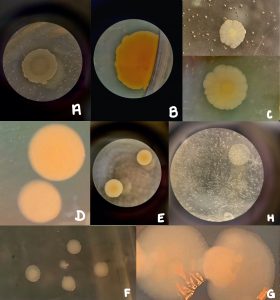8 What Are Wolbachia and Why Are They Important?
Liam McGouldrick and Mackenzie Mee
Authors: Liam McGouldrick and Mackenzie Mee
Abstract
The microbiome is becoming better understood in a variety of organisms. It has been shown to influence reproduction, development, and pathogen resistance; however, there is currently little understanding of the microbiome of the house cricket, Acheta domesticus, including whether the symbiotic microbe Wolbachia is present. A. domesticus serves as an excellent model because Wolbachia has been found in many other insect taxa and has been used to survey ecological immunity in the past. This study will discern whether Wolbachia exist in A. domesticus. We will extract 16s rRNA from the reproductive-tract of one female and one male cricket. Wolbachia genes will then be selectively amplified using PCR. Finally, gel electrophoresis will screen for Wolbachia rRNA. We expect that if there is Wolbachia, they will primarily be in the reproductive tract. Without Wolbachia, we anticipate that several other taxa will dominate the microbiome. Additionally, we will plate cricket saliva from male and female crickets on standard LB Agarose medium and record the resulting colonies. This will allow us to grasp the constituents of the cricket foregut, a poorly understood region of the microbiome. We found that A. domesticus is not in symbiosis with Wolbachia, and we identified eight unique colony morphologies using our saliva plating technique. This study paves the way for future explorations of the microbiota residing in the cricket foregut.
Lay (Non-Scientist) Abstract
Once I was walking around with a few of my friends downtown when I saw a man walking around in a shirt that said, “You are what your bacteria eat.” At first glance, I thought this shirt seemed a little strange, but after exploring the microbiome more I discovered that what we eat actually has an effect on what bacteria, also known as microbiota, grow in the microbiome of our guts. Since the exploration of the microbiome has begun, people have started to watch what they feed their guts more carefully. Ever wonder why so many people today now eat lots of yogurts and drink probiotic filled drinks like Kombucha? It’s because they are filled with probiotics and these probiotics are believed to help the good bacteria grow in the microbiome of our guts.

Image above retrieved from nature.com

Image above retrieved from https://www.redbubble.com/shop/probiotic+stickers
The microbiome is a community of microbes that live within an organism. There are normally many types, and they can influence digestion, reproduction, development, and immune function, among many others. However, what many people don’t realize is that the gut microbiome does not only play a big role in the functions that have to do with food consumption and digestion, but that it also plays a huge role in several other bodily functions, including anything from mental processes to psychiatric illnesses.
One particularly important type of symbiotic bacteria is called Wolbachia, which is capable of killing uninfected crickets and finding ways to prevent them from reproducing. We needed to start our exploration of the cricket microbiome with Wolbachia because if they were there, that would change the nature of our work. In addition, we studied Acheta domesticus, or the common house cricket, because it has a simple anatomy, making it relatively easy to dissect and withdraw tissue samples from specific body regions.
After looking for Wolbachia and finding them to be absent, we grew the microbes in cricket saliva on agarose plates to identify key constituents. We chose to use saliva because it’s representative of the species present in the “foregut,” the equivalent of the crickets mouth and esophagus. We found eight unique colony types and photographed them. Our work continues the initial stages of cricket microbiome exploration, and next steps could be using genomic sequencing to identify key microbes throughout the cricket and determining their effect on cricket physiology.
Research Question
Are Wolbachia present in Acheta domesticus? If they are, how do they affect the crickets? If absent, what other groups are there?
Methods/Results
We took samples of reproductive tissue from a female and male cricket and isolated the DNA present. Then we used PCR to amplify this DNA using primers that selected for two known Wolbachia regions and then used agarose gel electrophoresis to detect this DNA. We included two fruit flies, one with and one without Wolbachia, as positive and negative controls. Here’s a picture of the gel from our electrophoresis:

With this technique, DNA appears as a band. This band will travel a certain distance through the gel based on its size. The runged structures you see on the far left and right are ladders that we used to measure this distance, in turn telling us the size of the band. With this information, we compared the band size to the one we are looking for (the one amplified by the two Wolbachia primers from the PCR). Our gel only shows one band present – the Wolbachia band from one of the positive controls, a fruit fly. Therefore, we concluded the absence of Wolbachia in house crickets and proceeded with the next phases of our work.
First we collected saliva from four cricket types (young male/female, old male/female). This step of our experiment sounds quite strange, and trust me it kind of was. Collecting spit samples from crickets is not an everyday task that most people do and it sounds much more complicated than it really is. To collect the spit samples from the crickets we first selected crickets from each group and rubbed them on their abdomen and back to make them irritated. Once the crickets were irritated enough they would spit, as a way to show us just how unhappy they were with us, which then provided us with the spit sample that we needed. And for any of you who were wondering what cricket spit looks like, it is not pretty. It has a thick consistency that is a nasty yellowish/brownish color. I would also like to note that no crickets were harmed during the collection of these spit samples and that although crickets are small, when they get mad they let you know it.
Once the spit samples were collected from each of the groups, we plated them on a medium capable of growing bacteria known as LB agarose. We then left the plates inside an incubator for a few days until colonies started to show. Then, we looked at them under a microscope and described their morphology based on a few key traits (shape, size, surface, color, opacity, elevation, and margin). The photographs of our colonies are included here:

We found the above colonies and sorted them by the age and sex of their cricket host. Here’s a table describing that data:
| Cricket Age and Sex | Colonies Found |
| Adolescent Female | A, B, C, H |
| Adolescent Male | C, D, H |
| Adult Female | E, F, G |
| Adult Male | E, H
|
Since there were a few differences between the groups, we can conclude that sex and/or age is a factor in microbiome composition. This will need to be demonstrated further in future work in order to be solidified.
Significance and Future Research Directions:
By not having Wolbachia, the cricket microbiome is likely distinct from other insects, as Wolbachia is a very common symbiont. Wolbachia is also known to interfere with insect reproductive cycles, lifespan, and immunity, Without it, there’s a possibility other cricket microbes have evolved similar functions, particularly pertaining to immune response. This is significant because this presents an opportunity to look for convergent evolution across microbiomes, or unrelated bacteria evolving to fill a very similar niche. Future research could explore this possibility.
Our exploration of the foregut inhabitants offers a first step into developing a better understanding of the cricket microbiome. This is significant because microbiomes have been shown to influence a number of factors including immune function, digestion, and development in many organisms, including humans. Therefore, a step forward in exploring one microbiome and its effects upon the host may have critical implications for comprehending them in general. Recent work has looked at the human microbiome in depth, and it is now being used to treat conditions such as irritable bowl syndrome. Further understanding the links between microbiome and host physiology in crickets could revolutionize our knowledge of them in humans.
Suggested Readings
• Mezouar, S., et al. (2018). Microbiome and the Immune System: From a Healthy Steady-State to Allergy Associated Disruption. Human Microbiome Journal, 10, 11–20. Retrieved from https://www.sciencedirect.com/science/article/pii/S2452231718300095
• Smith, Chad C., et al, (2017). Spatial Structure of the Mormon Cricket Gut Microbiome and Its Predicted Contribution to Nutrition and Immune Function. Frontiers. Retrieved from www.frontiersin.org/articles/10.3389/fmicb.2017.00801/full.
• I Contain Multitudes, Ed Yong.
